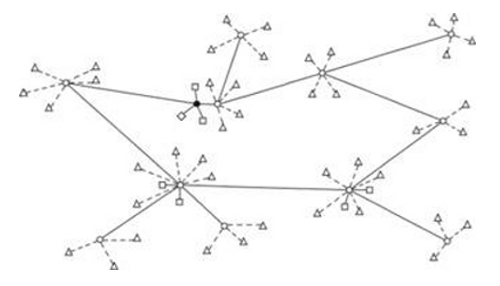Εδώ δεν αναφέρεται ότι οι Σοβιετικοί ανακαλύψαν το συγκεκριμένο δίκτυο που σήμερα καλείται με τον generic όρο internet. Εδώ έχουμε να κάνουμε με ροτέησον αχυράνθρωπου.
Αυτό που αναφέρεται είναι ότι Σοβιετικοί επιστήμονες στα τέλη του 50 - αρχές 60 ήταν στην πρωτοπορία της επιστήμης των δικτύων και ότι πέρα απο μια σειρά δικτύων αμυντικής φύσης, είχαν διαμορφώσει σοβαρές ρεαλιστικές προτάσεις για την δημιουργία ενός υπερδικτύου/διαδικτύου με στόχο τον έλεγχο/διαχείριση κεντρικά σχεδιασμένης οικονομίας. Δεν επρόκειτο για τίποτε φαντασμένους, αλλά για θεωρητικούς μαθηματικούς πλανητικής κλάσης που σήμερα έχουν περάσει στο επιστημονικό πάνθεο.
Όσον αφορά την ονοματολογία, οι Σοβιετικοί δεν χρησιμοποιούσαν καν τον όρο δίκτυο αλλά τον όρο σύστημα.
Δεν θα περίμενε κανείς βέβαια τίποτα διαφορετικό εκείνη την εποχή. Δεν σνομπάρω το τεχνολογικό επίπεδο που παρουσιάζει το άρθρο ότι είχαν οι Σοβιετικοί. Η ένσταση μου είναι για τον πιασάρικο τίτλο που λέει ότι έχουμε να κάνουμε με κάτι που παραλίγο να ήταν το internet.
Δεν είναι μόνο το τεχνολογικό, που εκείνη την εποχή ήταν ανταγωνιστικό, αλλά και το θεωρητικό. Παράδειγμα
At other times, Russian terms reveal their own world in how they resist easy translation. I occasionally retain, for example, the early Soviet term for computer, “the automatic high-speed electronic calculating machine” (avtomaticheskaya byistrodeistvuyushchaya elektronicheskaya schyotnaya mashina and its various shortenings) for its splendidly descriptive bulk that signals perhaps the most elegant definition of new media I know: new media are those media we do not yet know how to talk about [29]. The probability theorist Aleksandr Ya. Khinchin revealingly renders what is known in English as “queuing theory” (used by information theorists to describe how data packets wait in line) as “mass-service theory” (teoria massovogo obsluzhivaniya) in Russian [30]. Sustaining the anthropological gaze requires depicting the variable sets of cultural, social, and political values in comparative relief with the network elements that are all too familiar in modern culture, which I have attempted to do here whenever relevant.
http://firstmonday.org/ojs/index.php/fm ... /6689/5482
Single queueing nodes are usually described using Kendall's notation in the form A/S/C where A describes the time between arrivals to the queue, S the size of jobs and C the number of servers at the node.[5][6] Many theorems in queueing theory can be proved by reducing queues to mathematical systems known as Markov chains, first described by Andrey Markov in his 1906 paper.[7]
In 1909, Agner Krarup Erlang, a Danish engineer who worked for the Copenhagen Telephone Exchange, published the first paper on what would now be called queueing theory.[8][9][10] He modeled the number of telephone calls arriving at an exchange by a Poisson process and solved the M/D/1 queue in 1917 and M/D/k queueing model in 1920.[11] In Kendall's notation:
M stands for Markov or memoryless and means arrivals occur according to a Poisson process
D stands for deterministic and means jobs arriving at the queue which require a fixed amount of service
k describes the number of servers at the queueing node (k = 1, 2,...). If there are more jobs at the node than there are servers, then jobs will queue and wait for service
The M/M/1 queue is a simple model where a single server serves jobs that arrive according to a Poisson process and have exponentially distributed service requirements. In an M/G/1 queue, the G stands for general and indicates an arbitrary probability distribution. The M/G/1 model was solved by Felix Pollaczek in 1930,[12] a solution later recast in probabilistic terms by Aleksandr Khinchin and now known as the Pollaczek–Khinchine formula.[11][13]
After the 1940s queueing theory became an area of research interest to mathematicians.[13] In 1953 David George Kendall solved the GI/M/k queue[14] and introduced the modern notation for queues, now known as Kendall's notation. In 1957 Pollaczek studied the GI/G/1 using an integral equation.[15] John Kingman gave a formula for the mean waiting time in a G/G/1 queue: Kingman's formula.[16]
The matrix geometric method and matrix analytic methods have allowed queues with phase-type distributed inter-arrival and service time distributions to be considered.[17]
Problems such as performance metrics for the M/G/k queue remain an open problem.
https://en.wikipedia.org/wiki/Queueing_theory
Το ποστ του itteithe δίνει καλή πάσα για να δούμε με λεπτομέρεια, ποιοί ήταν οι σαημπερνετιστές της ΕΣΣΔ



